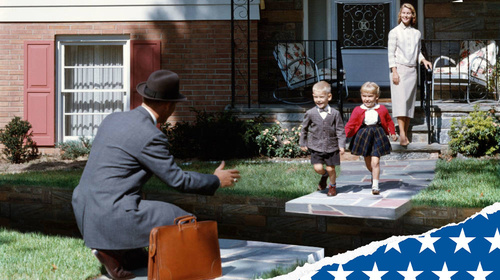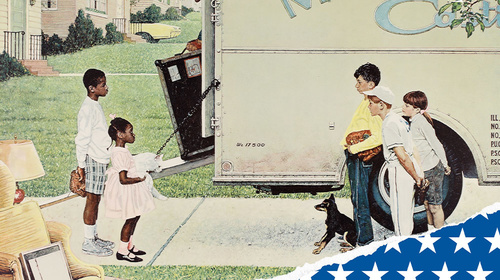Exhibitions
The CCCB dismantles the imaginary of the American dream
'Suburb. The construction of the American dream' reviews the most controversial aspects of the American model of life and analyzes its social contradictions

The Contemporary Culture Center of Barcelona (CCCB) has presented the exhibition Subúrbia. The construction of the American dream that can be seen until September 8. The exhibition traces the cultural history of the American dream, an ideal of life widely disseminated through literature, television and cinema, and analyzes the most controversial aspects of the model. Curated by the journalist Philipp Engel, the tour delves into the imagination of the idyllic family home with garden, swimming pool and two cars and shows the contradictions of this model such as the social, ethnic or gender segregation that derives from it as well as its environmental impact. There are pieces by names like Jessica Chou, Gregory Crewdson or Thomas Doyle.
The exhibition traces the origins of residential neighborhoods in the early 19th century, explains how they developed massively in the 1950s and reviews the economic, political and social context that made possible their unstoppable expansion across the United States.
One of the outstanding questions of the initiative is to analyze the environmental consequences of a model based on continuous journeys by car. But the exhibition also explains in 'MacMansion' how some residential areas became a paradigm of ostentation because citizens decided to live there in order to build large mansions in an economical format.
It is also reported how white people chose to change their residence and go to live in places without the presence of people of African American descent. However, the route exhibits the other side of the coin: the nightmare. How the fact of living in isolation spread fear among the citizens and contributed to the great fondness for weapons.

Using the American case as a pretext, the exhibition invites us to reflect on public space and cities. Through abundant historical material, photographs, paintings, audiovisuals, literature, works of art or everyday objects, the exhibition places us in the mental paradise of the residential neighborhood model inspired by American suburbia and invites us to rethink the value of the city and public space today.
As they explained, the exhibition decodes a landscape, almost abstract, that continues to be valid in pop culture and it does so through the work of outstanding creators who help us contemplate critically the famous American lifestyle.
Suburbia The construction of the American dream presents the work of outstanding creators who, from various points of view, help us contemplate critically the famous American lifestyle: Jessica Chou , Gregory Crewdson , Thomas Doyle , Gerard Freixes , Rodrigo Fresán , Gabriele Galimberti , Weronika Gesicka , Benjamin Grant , Todd Hido , Joel Meyerowitz , Matthias Müller , Blanca Munt , Alberto Ortega , Bill Owens , Sheila Pree Bright , León Siminiani , Todd Solondz , Amy Stein , Greg Stimac , Angela Strassheim , Deborah Stratman, Ed & Deanna Templeton , Kate Wagner and Christopher Willan.
The impact of the American dream in Catalonia
One of the exhibition spaces of the CCCB analyzes how the American model has arrived in Catalonia. The director of the Urbanization Observatory of the UAB, Francesc Muñoz, explained that the American dream impacted Catalonia with two key waves.
The first came in the 60s with the first second residences in housing estates. The second was more massive towards the 80s with the expansion of urbanizations in wider territories through terraced houses. "These developments jumped from one metropolitan crown to another," he recalled.
According to Muñoz, these cultural bases of urbanization have to do with a whole series of images consumed throughout the 20th century of the American dream. However, it also contributed to the fierce criticism towards the industrial cities of the 19th century or the garden cities made in Europe.
Muñoz explained that the appearance of these urbanizations was accompanied by the construction of large shopping centers, which moved away from urban centers to be more connected to the highways.








